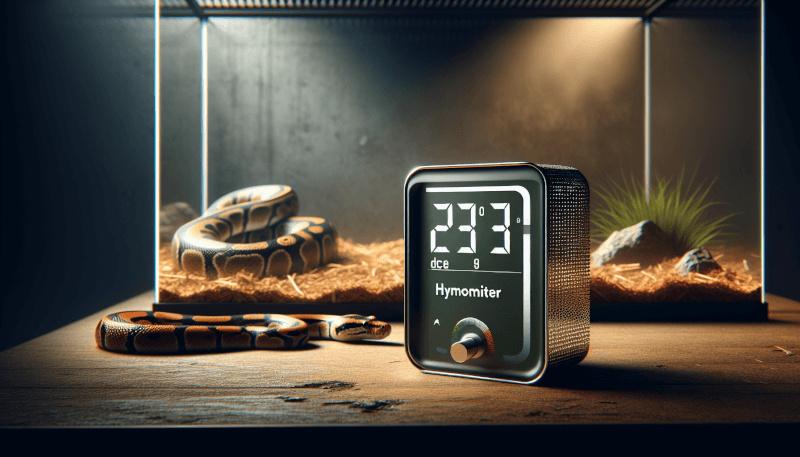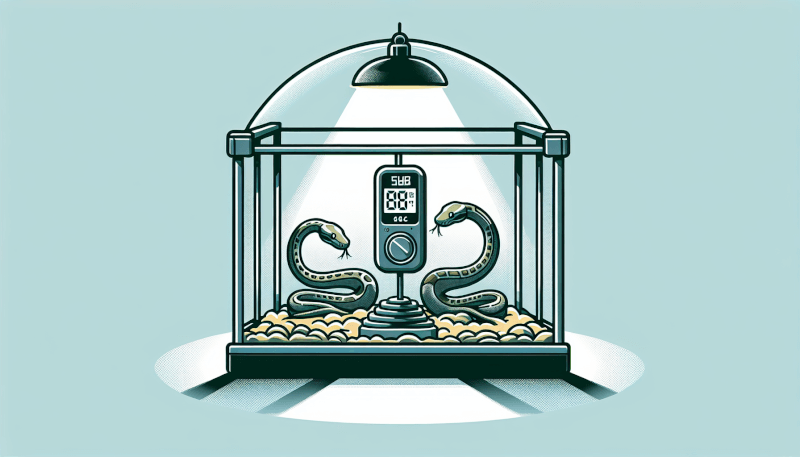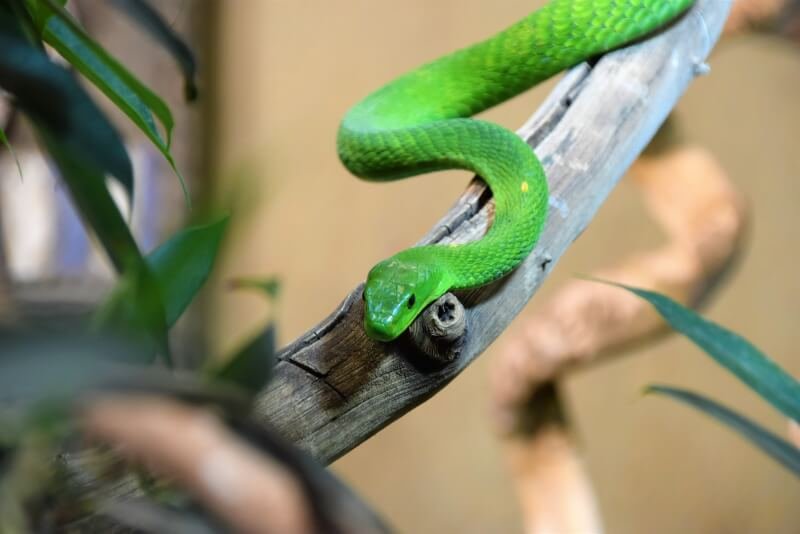Ensuring the proper humidity levels in your snake’s enclosure is crucial for their overall health and well-being. In this article, you will discover the best ways to monitor and maintain the ideal humidity levels, providing your snake with a comfortable and optimal environment. By following these simple yet effective methods, you can create a habitat that replicates their natural habitat, ensuring they thrive in captivity. From measuring humidity levels accurately to implementing various techniques to adjust humidity, this article will equip you with the knowledge needed to offer your scaly friend the perfect living conditions.
Choose the Right Enclosure Type
When it comes to selecting the right enclosure for your snake, there are a few factors to consider. First, think about the size of the enclosure. You’ll want to choose one that is spacious enough for your snake to move around comfortably. A cramped enclosure can cause stress for your snake and make it difficult for them to regulate their body temperature.
Next, consider the material of the enclosure. There are various options available, such as glass, plastic, or wood. Each material has its own advantages and disadvantages, so it’s important to do your research and choose one that best suits your snake’s needs. Glass enclosures are popular because they provide good visibility, while plastic enclosures are lightweight and easy to clean. Wood enclosures, on the other hand, provide insulation and a more naturalistic environment.
Use Appropriate Bedding
Choosing the right bedding for your snake’s enclosure is crucial for maintaining proper humidity levels. Some substrates hold moisture better than others, so it’s important to choose one that will retain moisture and help maintain humidity in the enclosure.
Avoid using bedding that promotes mold growth, as this can be harmful to your snake’s health. Some examples of bedding to avoid include cedar shavings and newspaper. Instead, consider using substrates such as cypress mulch, coconut coir, or sphagnum moss, which hold moisture well and create a more humid environment.
Provide a Water Source
Having a water source in your snake’s enclosure is essential for maintaining proper humidity levels. The size and placement of the water bowl are important considerations.
Choose a large water bowl that is sturdy and non-tippable. This will prevent your snake from accidentally knocking it over and spilling water, which can decrease humidity levels. Place the water bowl in a location that is easily accessible for your snake but doesn’t interfere with their movement around the enclosure.
Ensure that fresh water is always available to your snake. This means regularly cleaning and refilling the water bowl to prevent bacteria growth and ensure the water is clean and safe for your snake to drink.
Utilize Humidity-Enhancing Tools
In addition to proper bedding and a water source, there are several tools you can use to enhance humidity levels in your snake’s enclosure.
Consider installing a reptile-specific humidifier. These devices are designed to emit a fine mist of water into the enclosure, increasing humidity levels. Be sure to follow the manufacturer’s instructions on how to properly set up and use the humidifier.
Another humidity-enhancing tool is a substrate mist system. These systems release a fine mist of water directly onto the substrate, creating a more humid environment. They can be set on a timer to mist the enclosure at specific intervals.
Monitor Humidity Levels
Monitoring humidity levels in your snake’s enclosure is crucial for maintaining their health and well-being.
Invest in a digital hygrometer, a device specifically designed to measure humidity levels. These devices are easy to use and provide accurate readings. Place the hygrometer in a central location within the enclosure, ensuring it is not obstructed by any decor or furniture. This will give you a good idea of the overall humidity within the enclosure.
Regularly check the hygrometer readings to ensure that humidity levels are within the appropriate range for your snake species. Different snake species have different humidity requirements, so it’s important to do your research and understand the specific needs of your snake.
Create a humidity chart to track the humidity levels in your snake’s enclosure over time. This will help you identify any trends or fluctuations and make necessary adjustments to maintain proper humidity levels.
Adjust Humidity Using Natural Methods
In addition to the use of humidity-enhancing tools, there are natural methods you can employ to adjust humidity levels in your snake’s enclosure.
One method is to increase humidity by adding live plants to the enclosure. Plants release moisture through a process called transpiration, which can help increase humidity levels. Choose snake-safe plants that can thrive in the enclosure’s environment and provide additional benefits such as hiding spots for your snake.
Another natural method is to create a moist hide for your snake. This is a small area within the enclosure that is kept consistently moist. Your snake can retreat to this hide if they need additional humidity. Use a hide box made of a water-resistant material and place a damp substrate, such as moss or damp paper towels, inside. This will help create a microclimate of increased humidity.

Regularly Clean and Maintain the Enclosure
Maintaining a clean and hygienic enclosure is important for your snake’s health and to prevent issues with humidity levels.
Remove soiled bedding and replenish it as needed. Snakes produce waste, and if left sitting in the enclosure, it can lead to bacterial growth and odors. Regularly spot clean the enclosure and replace bedding to maintain a clean and fresh environment.
Clean and disinfect the water bowl regularly. Bacteria and algae can grow in the water over time, so it’s important to clean the bowl and provide fresh water to your snake. Use a reptile-safe disinfectant and rinse the bowl thoroughly before refilling.
Inspect and clean the humidity-enhancing tools regularly. Over time, these tools can accumulate mineral deposits or become clogged, affecting their functionality. Follow the manufacturer’s instructions on how to clean and maintain these tools to ensure they are working effectively.
Addressing Low Humidity Issues
If you find that the humidity levels in your snake’s enclosure are consistently low, there are a few steps you can take to address this issue.
Increase the size and number of water sources. Adding additional water bowls or increasing the size of the existing bowl can help provide more moisture in the enclosure. This can increase humidity levels and create a more suitable environment for your snake.
Consider using a humidifier specifically designed for reptiles. These devices release a fine mist of water into the enclosure, increasing humidity levels. Be sure to follow the manufacturer’s instructions on how to properly set up and use the humidifier.

Addressing High Humidity Issues
On the other hand, if you find that the humidity levels in the enclosure are consistently high, steps can be taken to address this as well.
Improve ventilation in the enclosure. Proper airflow is important for preventing excessive humidity. Ensure that there are vents or small openings in the enclosure to allow for air circulation. This will help decrease humidity levels and prevent the growth of mold or mildew.
Reduce the frequency of misting. If you are using a substrate mist system or hand misting your snake’s enclosure, try reducing the frequency. Misting too often can lead to excessive humidity. Monitor the hygrometer readings and adjust misting accordingly to maintain proper humidity levels.
Seek Professional Advice if Needed
If you’re having difficulty maintaining proper humidity levels in your snake’s enclosure, don’t hesitate to seek professional advice.
Consult with a reptile veterinarian who can provide guidance and recommendations specific to your snake’s needs. They can help identify any underlying issues and offer solutions to maintain proper humidity levels.
Join online reptile communities for advice and support. There are many forums and groups where reptile enthusiasts share their experiences and offer advice. They can help troubleshoot any issues you may be facing and provide recommendations based on their own experiences.
Remember, maintaining proper humidity levels is crucial for your snake’s health and well-being. By choosing the right enclosure type, using appropriate bedding, providing a water source, utilizing humidity-enhancing tools, monitoring humidity levels, adjusting humidity using natural methods, regularly cleaning and maintaining the enclosure, and seeking professional advice when needed, you can create a comfortable and healthy environment for your snake.



